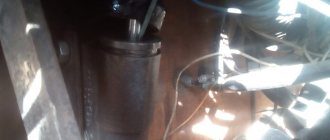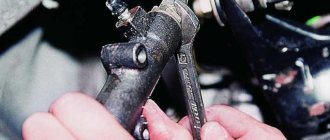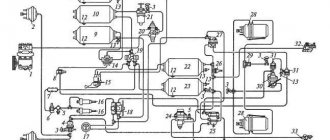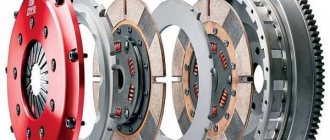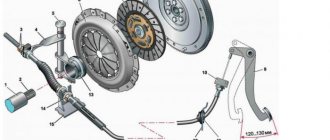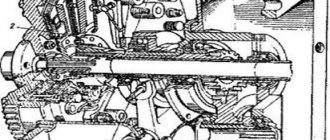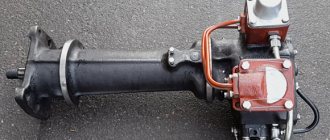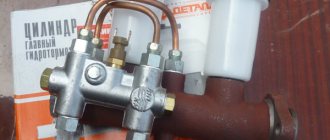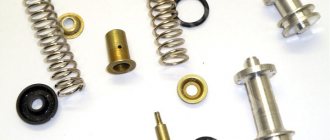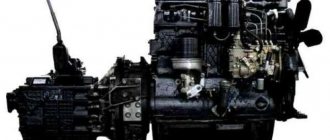The clutch is an important element in the design of a car, allowing you to “connect” the engine and gearbox, as well as realize the possibility of comfortable changing gears, eliminating shock loads, etc.
The clutch design on different cars may differ, while modern vehicles often use a hydraulic clutch. Among the main components of the hydraulic clutch system, the main cylinder (clutch master cylinder) should be highlighted.
The purpose of such a cylinder (sometimes called the clutch release cylinder) is to effectively transfer force from the clutch pedal to the clutch release fork. This fork presses the release bearing, which allows this mechanism to operate due to interaction with the clutch basket petals.
Design and principle of operation of the GCS
To begin with, a hydraulic clutch consists of a pair of cylinders (clutch master and slave cylinders) that allow the clutch to operate hydraulically. As for the master cylinder, the design of the main cylinder and its operating principle is as follows:
- the force from the clutch pedal is transmitted through the pusher to the rod. Next, the piston extends, as a result the valve closes, as a result of which the liquid from the part of the cylinder where it is compressed is able to flow into a separate tank;
- the liquid compressed in the cylinder is pushed through the fitting, after which it enters the hydraulic line, through which it is supplied to the working cylinder;
- the working cylinder acts on the fork, transmitting force to it. After the driver releases the clutch pedal, the piston of the cylinder returns back using a spring.
As you can see, the clutch hydraulic drive works similarly to other systems (for example, the hydraulic brake system), which are based on a fluid that is almost not compressed under pressure, but there is an effective and quick transfer of force to the actuators.
Please note that when choosing a new part, you must take into account individual technical characteristics, method of fastening, connection, the presence of a tank in the kit, body material, dimensions, rod length, fitting diameter, etc.
In other words, when choosing a master cylinder for a particular car, you need to take into account a number of parameters and features. It is also recommended to pay special attention to the material of manufacture. The fact is that cylinders can be either steel, aluminum or cast iron, or plastic (made from polymers).
Products made of cast iron and aluminum are quite common and are an “average” option in terms of quality; plastic cases are the most affordable, but are not always reliable and have a long service life. As for steel, such cylinders are the most reliable, but have a high cost due to the complexity of manufacturing.
Bleeding the system, adjusting the pedal
Having installed the repaired or new cylinder in place, connecting a hydraulic hose to it, you should bleed the system and adjust the height of the clutch pedal.
Bleeding after replacing the working cylinder is done in the same way as that done after repairing the master cylinder, but in some brands of cars, for example Fiat, this procedure is done the other way around. To “reverse” pumping yourself, you will need:
- a hose of such a diameter that it fits tightly onto the outlet valve;
- a special or just a large syringe with a spout diameter suitable for the hose;
- key for unscrewing the air release valve.
Unscrew the lid of the fluid reservoir. We fill the syringe with hydraulic fluid and expel all the balloons from it, connect one end of the hose to the valve, the other to the syringe. After unscrewing the air valve a couple of turns, press the syringe and inject the liquid into the cylinder. Without removing the hose, tighten the valve so that no air gets in.
This procedure should be performed several times until the final release of air from the system into the tank. Then press the clutch pedal up to ten times and, if necessary, adjust its height.
Source
Malfunctions and repairs of the clutch master cylinder
If we talk about the GCS, like any other device, this element can also fail. Although the clutch master cylinder is simple in design and reliable, over time individual elements wear out due to constant loads, especially if the car is operated in the city.
As a rule, seals and rubber parts are the first to fail. To put it simply, such sealing elements should be understood as boots that are put on the rod to protect the cylinder from dirt and small abrasives, as well as sealing collars that do not allow the working fluid to leak out.
Another element that can cause problems with the cylinder head is the spring in the cylinder. The spring of the clutch master cylinder constantly experiences loads during vehicle operation, and it is also affected by the brake fluid, which in this case performs the working function. When the metal becomes more brittle, the spring may simply burst.
One way or another, if there is a problem, the cylinder needs to be replaced. At the same time, in a number of cases it is also possible to get by with repairing the main central heating system rather than replacing it. Taking into account the relatively high cost of the part for many cars, this method is optimal. For these purposes, you need to purchase a clutch cylinder repair kit, which includes the necessary spare parts.
This approach usually allows you to sort out the device and completely restore its functionality. The main thing is that the repair kit is of high quality, and that the repair of the clutch master cylinder itself is carried out by experienced specialists.
What to consider when choosing
Almost every automaker creates working cylinders exclusively for their cars. Comparing the cylinders from Ssang Yong and Nissan, you can see that they have different shapes, are mounted differently, and the first one even has a release bearing mounted on it. They also probably have different rod lengths and connections to the actuator. So you can choose the right working cylinder in three ways:
- VIN code of the car . Contact the store and use the transport code when selecting. So you will find both the original cylinder and its analogues. There is zero chance of making a mistake;
- Car data . Their list includes body, make, engine data, year of manufacture. The year of manufacture is especially important. Even within the same line of cars, those produced in different years may have different RCS;
- Old part code . It's very simple: find out the code of the already installed working cylinder and select the same one. It is also possible that in this way you will be able to find compatibility sheets for working cylinders, which will contain the code for an existing part and identical analogues.
Spare parts for hafei princip
Rear brake pads, drum
Spare parts for Nissan 370 z
Transmission oil
In general, the choice will not be difficult. However, you should not forget: even similar external parts may have different “fillings”. Collect as much information as possible, or better yet, search directly by VIN code - you won’t go wrong.
Causes and symptoms of GCS malfunction
As mentioned above, wear and tear of individual cylinder elements is inevitable over time. Also, premature failure of a part can be caused by untimely replacement of brake fluid, ruptures of seals, errors in assembling/installing individual spare parts from the repair kit, etc.
As a rule, the most serious damage can be considered when the mirror of the cylinder itself is heavily worn, scuffs, abrasions and other defects appear on the metal surface, and pockets of corrosion are visible. In such a situation, a conventional overhaul using a repair kit is often not possible. The only solution is to completely replace the clutch master cylinder.
The fact is that one of the properties of brake fluid is high penetrating ability. This means that fluid seeps through even the smallest scratches on the cylinder bore and/or piston. Replacing only the rubber seals does not help in this case.
We also recommend reading the article about whether there is a clutch in an automatic transmission. From this article you will learn what devices and mechanisms in an automatic transmission perform the clutch function, as well as how the clutch works in an automatic transmission.
Often, a high-quality GCS repair kit usually has both cuffs and a new piston. However, if there are scratches on the cylinder mirror, in this case the entire part needs to be replaced. For this reason, it is important to prevent critical wear and tear by paying attention to the slightest signs of failure of the main circulation system. As soon as a problem occurs in the cylinder, fluid can leak out of the system and its level decreases.
Also, the clutch pedal may work worse; while driving, the driver notices that the gear shifting process is disrupted as a result of clutch malfunctions. If there are problems with the cylinder, the clutch pedal may fall to the lower position (fall, stick), the pedal travel becomes tight, etc.
In this case, a visual inspection must be carried out immediately. First of all, you should check the level and condition of the brake fluid. You also need to inspect the cylinder itself. If there are obvious stains on the cylinder or the seals (cuffs) are wet, then a leak is obvious.
We also note that a common problem with the clutch master cylinder is active clogging of the holes in the reservoir cap. In order for the device to work properly, it is assumed that the fluid level in the cylinder reservoir constantly rises and then decreases.
In order for the level to rise and fall normally, there are special ventilation holes in the tank lid. In cases where the holes are clogged with dirt, the entire hydraulic drive malfunctions, the clutch pedal moves hard, the clutch pedal slowly returns to its original position, etc.
What you can do yourself
The simplest repair is possible without the help of specialists at a service station . The first thing to do is determine whether a belt is needed at all. First bleed the hydraulic drive. This is done simply: connect the hose to the bleeder screw, then lower its other end into a container filled with brake fluid. Afterwards, fill the small reservoir of the master cylinder with liquid. Once inside the cabin, press the pedal. Air bubbles will begin to appear. If the process of their formation does not end, repairs are necessary.
Remove and disassemble the cylinder. You will need a metalworking tool and a vice in which it will be convenient to disassemble the cylinder. The protective cap and pusher are removed, the piston is removed and with a little effort the lock ring located on the piston is removed. Next you need to remove the spring and seals. Now the following is done: the fitting is washed with brake fluid, as well as the holes in the cylinder. It is strictly forbidden to wash parts with gasoline, oil or anything else. The seals are replaced with new ones. If necessary, the spring can also be changed. If there is no damage to the cylinder mirror or the outer surface, the cylinder can be assembled and put in place.
In case of serious mechanical damage to the metal element, the working cylinder will have to be replaced. In theory, its repair is possible in this case, but the residual life can vary from several tens of thousands of kilometers to a couple of hundred. We do not recommend taking risks.
Brand tour
The best option would be an OEM part. It fully meets all quality requirements. It will last a very long time and installs without problems. True, it costs a lot of money.
If your budget is limited, take an analogue. The best are produced by the following companies: LUK, Sachs, TWR (Germany). They are not very different from the originals. They cost significantly less. If the working cylinder of these companies is selected and then installed correctly, it will travel at least 150 thousand kilometers.
Inexpensive analogues are offered by these companies: JP Group (Denmark), Profit (Czech Republic), ABE (Poland). The quality is inferior to both the originals and more expensive analogues from the same LUK. However, you will still save money even if you replace it faster.
Which one is better to put
On the VAZ 2101 it is necessary to install a hydraulic clutch designed for the VAZ 2101–07. Cylinders designed to work in UAZ, GAZ and AZLK vehicles are not suitable for installation on a “penny” car. The situation is similar with imported analogues. It will be quite problematic to introduce a GVC from any foreign car, which is due to different mounting of the unit, different threads and tube configuration. However, a hydraulic drive from a VAZ 2121 or from a Niva-Chevrolet is suitable for the “classic”.
Manufacturer's choice
Today there are many companies that manufacture clutch master cylinders. However, when choosing and purchasing the unit in question, preference should be given to the following manufacturers:
- JSC AvtoVAZ;
- Brick LLC;
- Kedr LLC;
- Fenox;
- ATE;
- TRIALLI.
When choosing GVCs, it is better to give preference to well-known manufacturers
The average cost of a hydraulic clutch is 500–800 rubles. However, there are products that cost about 1,700 rubles, for example, cylinders from ATE.
Table: comparison of hydraulic clutch actuators from different manufacturers by price and reviews
| Manufacturer, country | Trademark | Cost, rub. | Reviews |
| Russia, Tolyatti | AvtoVAZ | 625 | Original GVCs are made with high quality and are more expensive than analogues |
| Belarus | Fenox | 510 | Original GVCs are inexpensive, made with high quality, and are popular among drivers |
| Russia, Miass | Brick Basalt | 490 | Improved design: the absence of a technological plug at the end of the cylinder and the presence of an anti-vacuum cuff increases the reliability of the product |
| Germany | AND THOSE | 1740 | The originals are of the highest quality. The price is tied to the EURO exchange rate |
| Germany | HORT | 1680 | Original GCS are reliable and durable in operation. The price is tied to the EURO exchange rate |
| Russia, Miass | Cedar | 540 | The original GVCs do not cause any particular complaints |
How to adjust the clutch rod on a VAZ 2106
After bleeding the working cylinder, it is necessary to adjust the clutch rod. To do this you will need:
- set of open-end wrenches;
- medium-sized caliper;
- pliers.
Adjustment sequence
Before you begin making adjustments, you should look at the machine's operating instructions . It is there that you can clarify all the necessary tolerances for the clutch rod and pedal.
- First, the clutch pedal play (also known as free play) is measured. The most convenient way to measure it is with a caliper. Normally it is 1–2 mm.
- If the free play exceeds two millimeters, then use a 10 mm open-end wrench to unscrew the nut located on the free play limiter. After this, you can turn the limiter itself and set the required free play of the pedal.
Video: how to adjust the clutch drive
Diagnostics.
Before you begin repairing or replacing the working cylinder, you need to make sure that the malfunction of this particular unit is bothering your car. There are several different ways that will allow you to determine the breakdown, without the help of specialists from various car services:
- when changing gears, the crunching of gears is clearly audible, and a beating appears in the gear handle;
- the clutch is not fully depressed;
- when examining the part of the working cylinder accessible to your eye, leaks were found (they may appear on the body or at the joints of the system hoses);
- the level of brake fluid in the barrel, its leakage will be associated with abrasion of the cuff or, even worse, with failure of the piston;
- when you press the clutch pedal, it sinks to the floor, which means there is air in the system (basically in such a situation you can get by with simply bleeding the air, but if that doesn’t help, you’ll have to replace the cylinder).
If diagnostics of the working cylinder reveal one of the reasons listed above, make repairs before the entire assembly fails.
